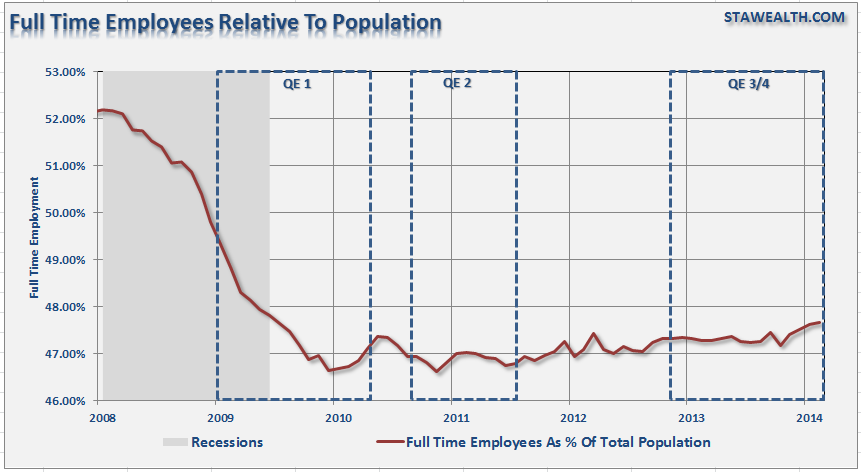Yesterday, Janet Yellen gave her first post-FOMC meeting press conference. In her prepared statement, she stated exactly what was already expected:
- accommodative policy will remain in place for a considerable amount of time after the current quantitative easing program ends this fall,
- employment is improving,
- the economy is recovering but has more work to do, and;
- the current quantitative easing program would be "tapered" from $65 to $55 billion per month beginning in April.
The problem for the markets came during her press conference when she was asked what a "considerable amount of time" between the end of the current QE program and the first rate hike would be. She replied: "About six months." It took the markets about 5-seconds to understand exactly what that meant: "Rate hike in early 2015." If you want to know the precise moment that those words were uttered, just look at the chart below to see if you can figure it out.
The question is this:
"If the Fed begins to hike interest rates, what effect does that have on the economy and the markets?"
According to Jim Cramer last night, he said the idea of rising interest rates shocked the markets, however, in the long-term it's a positive sign. Rates rise as the economy does better.
The assumption he makes is that as the economy "catches fire" and corporate profits increase, then it is natural for interest rates to rise also. If a growing economy is a function of expanding profitability, then what is wrong with the chart below. (For more detail read: 50% Profit Growth)
"The chart below shows corporate profits, per the BEA, divided by GDP. (You can substitute GNP but the result is virtually identical between the two measures.)"
"The current levels of profits, as a share of GDP, are at record levels. This is interesting because corporate profits should be a reflection of the underlying economic strength. However, in recent years, due to financial engineering, wage and employment suppression and increase in productivity, corporate profits have become extremely deviated."
Cramer, also correctly states that much of the profitability increases for corporations have come from stock buybacks and cost cutting. However, many of those stock buybacks and dividend increases (as with AAPL) have been financed with low interest rate debt issuance. If rates rise, this is no longer an option. The "cash on the sidelines" story is true to some degree as total liquid assets as a percentage of total assets is near all time highs. However, corporations have relevered balance sheets to a large degree due to the cheap cost of debt. The chart below shows the ratio of cash to debt.
As far as cost cutting goes, much of that has come from reducing employment. However, as the chart below of full-time employment relative to the population shows, corporations have likely "milked that cow dry."
The problem is that the data suggests that artificially low interest rates and ongoing monetary interventions have been a key driver of both market returns and corporate profitability. However, what has been lacking is sustainable, organic, economic growth.
With this background, the consequence of a hike in overnight lending rates (Fed funds rate) will likely have far more significant impact on corporate profitability, economic growth and market returns than currently believed.
In order to support that conclusion a historical look at Federal Reserve actions can give us clues about future outcomes. The first chart below shows the fed funds rate as compared to economic growth.
What is interesting is that a case can be made that the Federal Reserve's monetary policies are potentially complicit in both economic booms and busts. When the Federal Reserve has historically begun raising interest rates the economy has slowed down, or worse. Subsequently, the Fed has to reverse its policies to restart economic growth.
It is significant that each time the Fed has lowered the overnight lending rate, the next set of increases have never exceeded the previous peak. This is due to the fact, that over the last 35 years, economic growth has been on a continued decline. I have detailed this declining trend in the Fed funds rate below as compared to the S&P 500.
Increases in interest rates are not kind to the markets either. I have highlighted, with the vertical dashed black lines, each time the Fed has started increasing the overnight lending rates. Each time has seen either market stagnation, declines, or crashes. Furthermore, it is currently implied that the Fed funds rate will increase to 3% in the future, yet the current downtrend suggests that an increase to 2% is likely all that can be withstood.
As I said on Wednesday, I am currently fully allocated to the markets only because the markets are rising. However, it is important to understand investment risks are rising due to the changing fundamental environment. Rising interest rates will negatively impact earnings as borrowing costs rise, housing as mortgage costs increase, disposable incomes as debt costs rise, etc. With an economy that is nearly 70% driven by consumption there is little wiggle room for increased costs when incomes remain primarily stagnant.
My suspicion is that while Ms. Yellen stated that interest rates could rise as soon as 2015, it is possible that it will be far longer than that. That is unless we do somehow achieve an economic growth miracle starting six years into an ongoing recovery. Just because it has never happened in the past, doesn't mean it can't happen this time...right?






